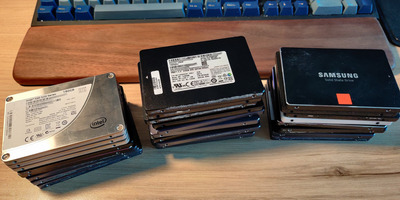Finally got around to TopBench-ing my machines - all that's left is the NEC Ready and Tandy 1000A....
Seems the speculation on the Moondog being the fastest 486 was right and follows my Quake observations (Quake runs on it almost perfectly at 320x200), though Creeping Net 486 almost came up even. Also seems my presumptions about the Versa P/75 and M/75 being very close was almost right on was well. Possibly the most glee though was the GEM 286 which equated to a 386 SX-16 machine (!!) because that's exactly how I've been describing that one in the whole 15 years I've had it.
Probably the best was Starbench on CN486 - 🤣 - MAXIMUM - 4096, it just kept going and going....if I put on a loop of white noise it would have been the perfect AMSR thing to sleep to, 🤣.
Now off to ready the "Ready" for it's test by getting through all those pending Win98SE updates, then I'll have to cut a 360K for the Tandy 1000A, probably will use the Compaq for that.
GEM 286
MemoryTest=530
OpcodeTest=207
VidramTest=300
MemEATest=272
3DGameTest=216
Score=32
CPU=Intel 80286
CPUspeed=12 MHz
BIOSinfo=R(C)1985-1989, American Megatrends Inc,.All Rights Reserved.1346 Oakbrook Drive, Suite-120, Norcross, GA-30093. Phone-(404)-263-8181. (04/30/89, rev. 0)
BIOSdate=19890430
BIOSCRC16=F102
VideoSystem=VGA
VideoAdapter=VGA, Tseng ET 4000, DRAM, 1024kb Video Memory
Machine=GEM Computer Products 286 (AT Clone)
Description=1989, Octek Rev. 5.1 Motherboard, Intel 80286/10, IIT 80c287/12, 1.44M/1.2M, SVGA, SoundBlaster Pro 2.0 CT-1600, 3Com EtherLink III
Submitter=CreepingNet
Compaq Deskpro 386s/20 (386 SX mode)
MemoryTest=256
OpcodeTest=179
VidramTest=305
MemEATest=232
3DGameTest=176
Score=50
CPU=Intel 386SX
CPUspeed=20 MHz
BIOSinfo=\CL GE S CAB2/NPBDJCIDQTJHLBHRAKCDMDJW(C)Copyright COMPAQ Computer Corporation 1982,91**** (03/12/91, rev. 0)
BIOSdate=19910312
BIOSCRC16=F29C
VideoSystem=VGA
VideoAdapter=VGA, Compaq AVGA, 512kb Video Memory
Machine=Compaq Deskpro 386s/20
Description=1991, No FPU, 1.44m/1.2m floppy, 212MB HDD, on-board VGA, Soundblaster 16 Value, LinkSys Ethernet
Submitter=CreepingNet
Compaq Deskpro 386s/20 (Blue Lightning, clock x2)
MemoryTest=165
OpcodeTest=145
VidramTest=301
MemEATest=205
3DGameTest=133
Score=103
CPU=IBM 486DLC BLX3
CPUspeed=40 MHz
BIOSinfo=\CL GE S CAB2/NPBDJCIDQTJHLBHRAKCDMDJW(C)Copyright COMPAQ Computer Corporation 1982,91**** (03/12/91, rev. 0)
BIOSdate=19910312
BIOSCRC16=F29C
VideoSystem=VGA
VideoAdapter=VGA, Compaq AVGA, 512kb Video Memory
Machine=Compaq Deskpro 386s/20 (Blue Lightning Clkx2)
Description=1991, 1.44M/1.2M, VGA, Ethernet, SoundBlaster 16 Value, upgraded with Evergreen Technologies "RevTo486" Upgrade Chip (IBM "Blue Lightning" 486DLC BLX3 - driver allows adjusting clock-speed of the chip in CONFIG.SYS)
Submitter=CreepingNet
NEC Versa 40EC
MemoryTest=164
OpcodeTest=87
VidramTest=237
MemEATest=129
3DGameTest=61
Score=103
CPU=Intel i486DX2 SL
CPUspeed=40 MHz
BIOSinfo=Copyright (C) 1985-1992 Phoenix Technologies Ltd. (04/19/90, rev. 0)
BIOSdate=19900419
BIOSCRC16=0437
VideoSystem=VGA
VideoAdapter=Western Digital WD90C24 1MB SVGA VESA
Machine=NEC Versa 40EC
Description=Laptop, Built March 1994, 20MB RAM, 80GB HDD, 640x480 9.4" Active Matrix LCD
Submitter=CreepingNet
Compaq Deskpro 386s/20 (Blue Lightning, Clock Tripled Mode)
MemoryTest=150
OpcodeTest=144
VidramTest=300
MemEATest=204
3DGameTest=132
Score=114
CPU=IBM 486DLC BLX3
CPUspeed=60 MHz
BIOSinfo=\CL GE S CAB2/NPBDJCIDQTJHLBHRAKCDMDJW(C)Copyright COMPAQ Computer Corporation 1982,91**** (03/12/91, rev. 0)
BIOSdate=19910312
BIOSCRC16=F29C
VideoSystem=VGA
VideoAdapter=VGA, Compaq AVGA, 512kb Video Memory
Machine=Compaq Deskpro 386s/20 (Blue Lightning CLKx3)
Description=1991, 1.44M/1.2M, on-board VGA, no FPU, SoundBlaster 16 Value, Linksys Ethernet, Evergreen Technologies "RevTo486" Upgrade Chip in Clock-Tripled Mode - settable via driver in CONFIG.SYS)
Submitter=CreepingNet
NEC Versa V/50C
MemoryTest=118
OpcodeTest=75
VidramTest=187
MemEATest=109
3DGameTest=53
Score=138
CPU=Intel i486DX2 SL
CPUspeed=50 MHz
BIOSinfo=Copyright (C) 1985-1994 Phoenix Technologies Ltd. (04/19/90, rev. 0)
BIOSdate=19900419
BIOSCRC16=97DC
VideoSystem=VGA
VideoAdapter=Western Digital WD90C24 1MB SVGA, VESA
Machine=NEC Versa V/50C
Description=Laptop, Built March 1995, 20MB RAM, 60GB HDD, 640x480 Active Matrix 9.4" Display
Submitter=CreepingNet
NEC Versa M/75HCP
MemoryTest=91
OpcodeTest=44
VidramTest=140
MemEATest=68
3DGameTest=30
Score=162
CPU=Intel i486DX4
CPUspeed=75 MHz
BIOSinfo=Copyright (C) 1985-1994 Phoenix Technologies Ltd. (04/19/90, rev. 0)
BIOSdate=19900419
BIOSCRC16=CAE2
VideoSystem=VGA
VideoAdapter=Chips & Technologies 65545 1MB SVGA, VESA
Machine=NEC Versa M/75HCP
Description=M/75 Franken-Laptop - 40MB RAM, 80GB HDD, 800x600 9.4" Active Matrix Display with 3M MicroTouch Capacitive Touch Screen
Submitter=CreepingNet
NEC Versa P/75
MemoryTest=62
OpcodeTest=18
VidramTest=151
MemEATest=11
3DGameTest=15
Score=222
CPU=Intel Pentium
CPUspeed=200 MHz
BIOSinfo=Copyright (C) 1985-1994 Phoenix Technologies Ltd. (04/19/90, rev. 0)
BIOSdate=19900419
BIOSCRC16=B7E6
VideoSystem=VGA
VideoAdapter=Chips & Technologies 65545 1MB SVGA, VESA
Machine=NEC Versa P/75HC
Description=Laptop, Built Jan 1995, 40MB RAM, 80GB HDD, 800x600 9.4" Active Matrix LCD
Submitter=CreepingNet
Creeping Net 486
MemoryTest=69
OpcodeTest=31
VidramTest=94
MemEATest=42
3DGameTest=25
Score=231
CPU=AMD Enhanced Am486DX4
CPUspeed=100 MHz
BIOSinfo=,d Software Inc. Awar,Copyright (C) 1984-94, Award Software, Inc. (10/17/95, rev. 0)
BIOSdate=19951017
BIOSCRC16=DFDF
VideoSystem=VGA
VideoAdapter=S3 805, 2MB, SVGA, VESA
Machine=Creeping Net 486
Description=FIC 486-PVT Motherboard (Socket 3), 512K L2 Cache, 64MB RAM (FP), Mobile Rack, SB AWE64, LinkSys Ethernet
Submitter=CreepingNet
Moondog 486 DX4-100 Tower
MemoryTest=61
OpcodeTest=30
VidramTest=95
MemEATest=35
3DGameTest=24
Score=235
CPU=AMD Am486DX4 SV8T
CPUspeed=100 MHz
BIOSinfo=(C)1985-1994,American Megatrends Inc.,All Rights Reserved,6145F Northbelt Parkway,GA-30071,USA.(404)-263-8181. (07/25/94, rev. 0)
BIOSdate=19940725
BIOSCRC16=B38F
VideoSystem=VGA
VideoAdapter=VGA, Cirrus CL-GD, Cirrus CL-GD54xx, VESA, 1MB Video RAM
Machine=Moondog Computers 486 (AT Clone)
Description=Built 1993, Rebuilt 2021. PC Chips M912 Socket 3 Motherboard with working Cache, Baby AT Tower Case, 1.44M Floppy, 80GB ATA-133 HDD, 52x Creative CD-ROM, VLB Graphics, SoundBlaster Vibra 16, SMC 8416 Ethernet,
Submitter=CreepingNet
